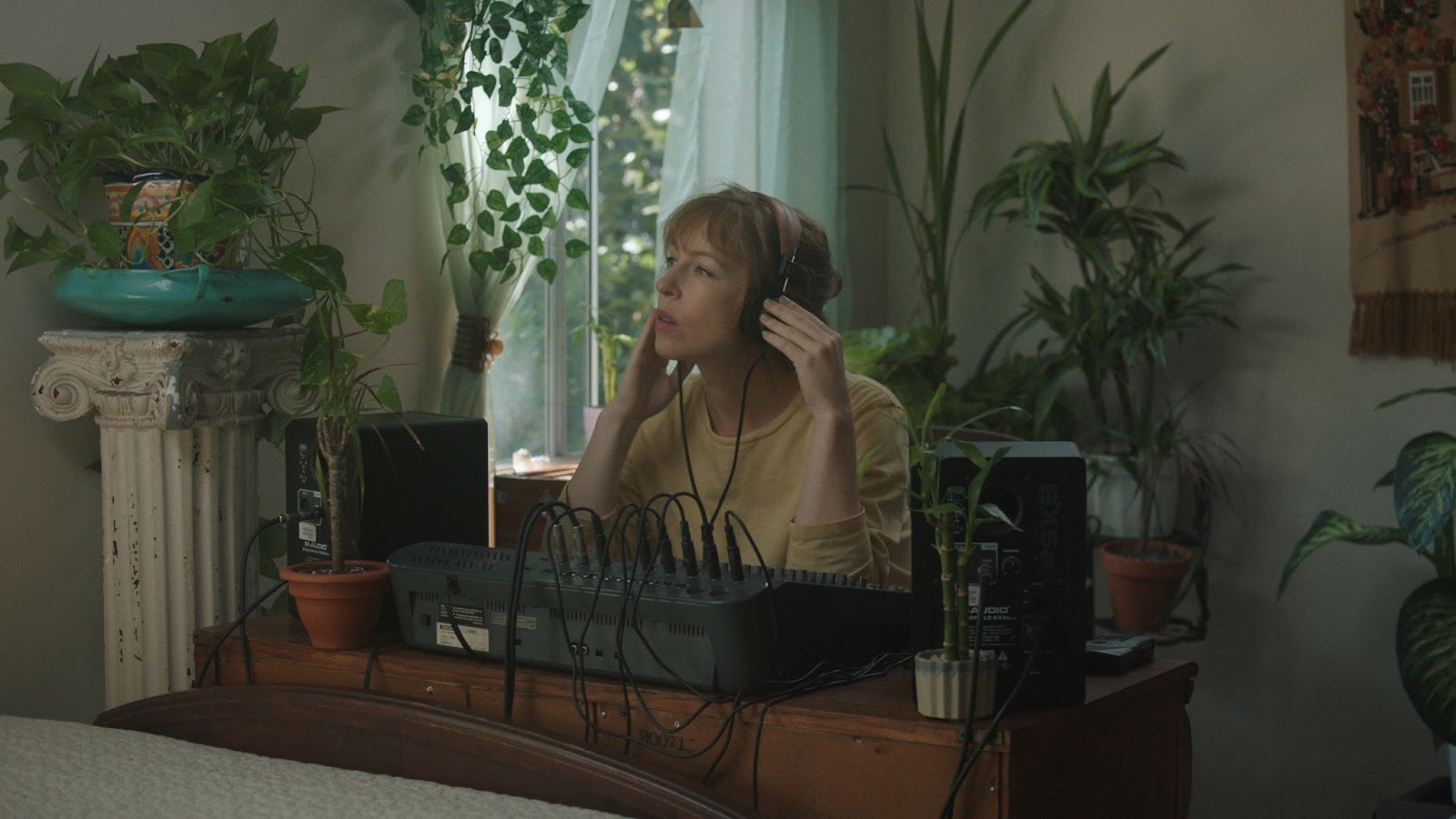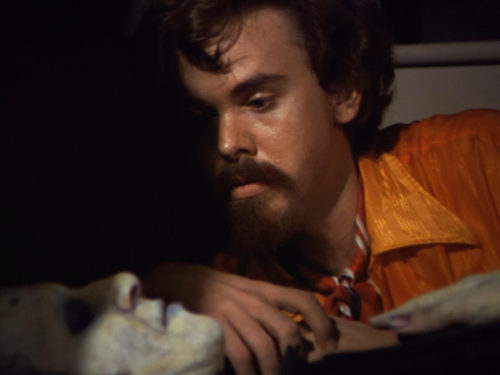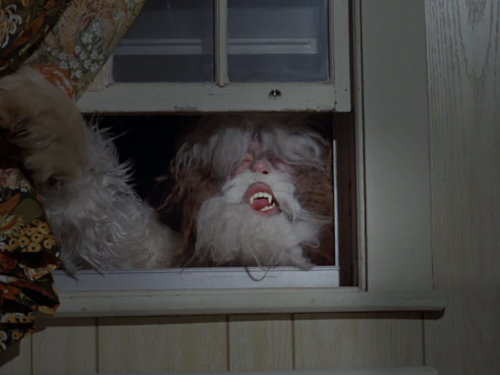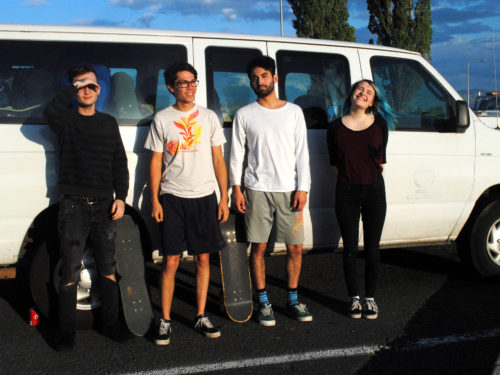Ahead of its U.K. debut, Davies sits down to discuss filming his first feature and finding inspiration in sometimes unlikely sources
In Topology of Sirens, one of the best films of the young decade, writer-director Jonathan Davies finds more than narrative and aesthetic inspiration in the point-and-click adventure games of his youth. The enveloping qualities of an almost wall-to-wall soundscape, the glow of Carson Lund’s cinematography, and the inviting sense of mystery hidden in every location and conversation generate an enigmatic kind of nostalgia, befitting a film that’s gentle without slipping into tweeness. You can practically hear the buzz of the tube TV long before Cas (Courtney Stephens) is surrounded by them at an independent station where an employee catalogs viewer-submitted tapes ranging from what look like expressionistic experiments to local commercials to digital snow.
Cas is in town (Los Angeles, provocatively unnamed and largely free of clear signifiers) following the death of an aunt. Reconnecting with friends from the experimental music scene and exploring the deceased’s home doesn’t close any loops or tie up any loose ends. Rather, every interaction presents at least some small discovery. Everything seems to invite new possibilities and raise new questions. A subtle sense that something is lingering behind a locked door sounds an imperceptible siren song, leading Cas to discover a hurdy-gurdy.
While the medieval instrument looks slightly less out of place than it might in a more typical cinematic L.A., we learn there’s a nearby emporium filled with them and staffed by a genial expert. There is no clear explanation, however, for the set of cassette tapes inside. Marked with unfamiliar symbols and featuring a range of mysterious recordings, the tapes send Cas on a journey whose singular locations, characters, and pacing calls to mind eccentric noirs like The Long Goodbye as much as long hours spent chatting with non-player characters and hunting for items in digital worlds.
To focus on influence is to sell Davies and the film short. Though the thrill of spotting analogues to the work of Michelangelo Antonioni and Apichatpong Weerasethakul defined my initial experience with Topology of Sirens, return visits to its world — lightly magical and then, suddenly, incredibly magical — have been less about collecting cinematic easter eggs. Rather than setting out to achieve 100% completion, I’ve instead adopted an approach that mirrors Cas’ attitude at the film’s close and accepted my smallness against its mysteries.
Just before the holidays, I spoke to Davies about the film (which screens in London this month), its musical qualities, the largely unexplored relationship between video games and slow cinema, and more.
UPDATE: Topolgy of Sirens is currently streaming on Mubi. Watch the film here.
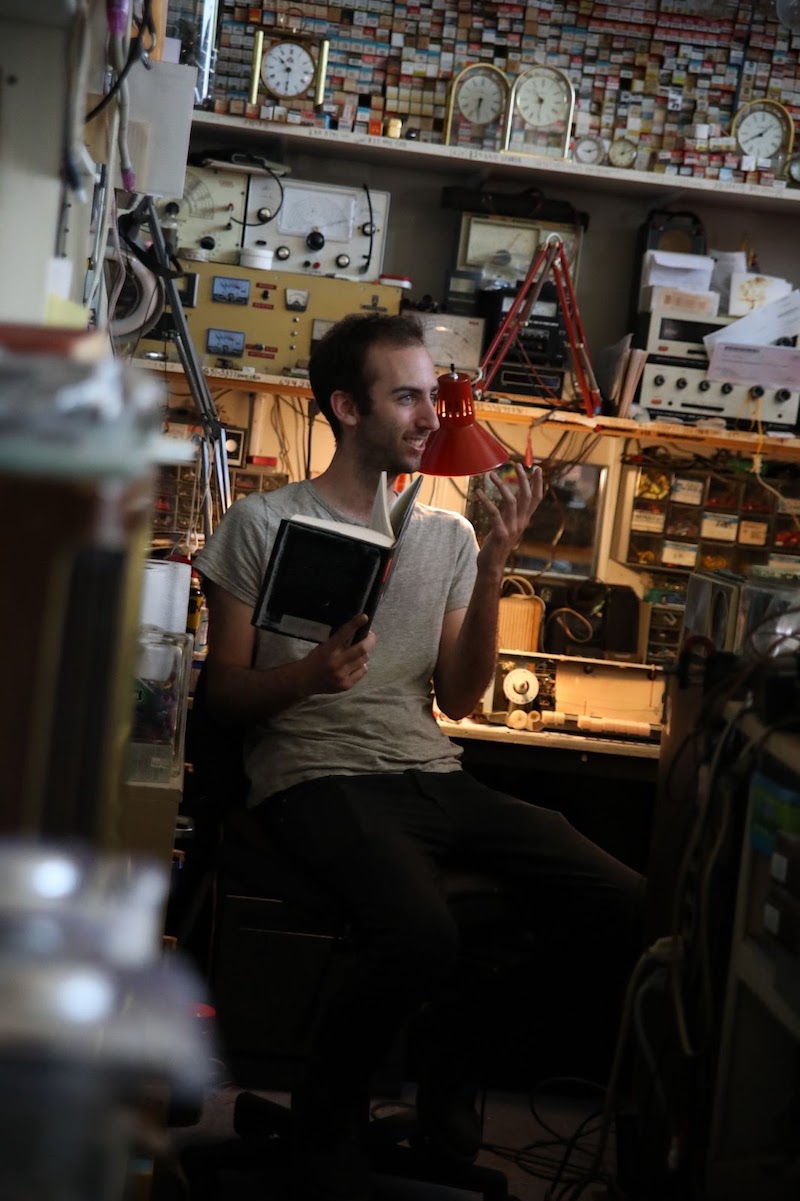
Split Tooth Media: I’m familiar with video games that aspire to a cinematic level of storytelling or immersion and the long history of video game adaptations, but you’re among the first filmmakers I’ve ever encountered who has named video games as an important influence on their work. What was it about ’90s point-and-click adventure games in particular that appealed, and how did they help to inspire the film?
Jonathan Davies: I think the big thing is that I grew up on them. I can remember playing them with my dad or my brother as early as 3 years old, or at least watching them play. On one level, it’s very ingrained as a type of visual storytelling. I think back to those games as much as I do films. It’s maybe even more instinctual since I got into them before I really got into cinema. The other thing is that I was drawn to mystery narratives, light mystery narratives, at the time I was writing the film. Even at their most light-hearted, these games are almost always charged by some sort of mystery with puzzles you need to solve by collecting the right items or talking to the right people. And I also think there is an unspoken, perhaps undiscovered, link between certain types of what might be called “slow cinema” or “master shot cinema” and these kinds of adventure games. There’s a very similar gaze and visual strategy to them. Then there’s someone like Jim Jarmusch, who I’m sure has probably never played one of these games, or maybe he has for all I know, but he’s made movies that so often resemble them visually. I’ve always gotten a kick out of that.
With all the odd L.A. locales, eccentric characters, and that slowly evolving mystery, I couldn’t help but (maybe a little reductively) think of Topology of Sirens as something like a more easygoing, sunlit noir film. You mentioned an immersion in mystery narratives. Did typically cinematic takes on the genre cross your mind at all?
It crossed my mind, but I’m not a noir junkie or anything like that. I saw someone refer to it as a “sun-dappled Long Goodbye.” I love The Long Goodbye, but I never thought of it while making Topology. When you make a mystery movie in L.A., though, those associations naturally come up. It’s funny; I cut it out of the script, but there was originally this whole thing about water, water flow, water supply, and I realized that there was a whole Chinatown connection I wasn’t thinking about. That might come back in the next movie.
Besides some of the foliage, I thought there was a certain any-place quality to the film’s locations. It’s probably my East Coast bias, but I thought of New England. Frankly, I’d be surprised if there wasn’t an actual hurdy-gurdy emporium somewhere in the Hudson Valley. Were you consciously avoiding familiar L.A. sites or maybe aiming for a mythical setting?
It’s funny you say you were reminded of the East Coast. Originally, I was envisioning something very David Lynch, you know, diners and deserts, but I dropped that quickly. As I was getting more into the film and the old music aspect I started to think about Boston. I grew up outside of Boston and went to school there. I thought it’d be great to make the film in New England. It wasn’t possible to travel at our budget, so I started thinking of places in L.A. that looked like New England. Those don’t really exist. Because I was foolishly trying to find those kinds of places, I still ultimately found places that don’t look like L.A. that I might not have found otherwise, these little corners that aren’t the stereotypical image of L.A. No one ever says Los Angeles in the film, so it was definitely not intended to take place anywhere specific. Some people have said it looks like France, or it looks like the Caribbean, or North Carolina, mostly places I haven’t been.
Music suffuses the film and we’re often carried from scene to scene through extended audio bridges. What do these accomplish or suggest for you?
I used to go to all of these shows in college and Tyler Taormina, who directed Ham on Rye and produced Topology, and I had a drone duo called Fjords. We played a bunch of shows in Boston and put out some stuff. I kind of wanted the film to reflect the experience of being at a show where you’re seeing a person play a set and there are no breaks and you’re kind of being carried by the sound throughout its duration. On a sound level, I wanted the film to work like an unbroken live set where even with just sound you’d have the feeling of being taken from beginning to end. There’s also a couple points where you can actually hear some pieces we recorded as Fjords, too.
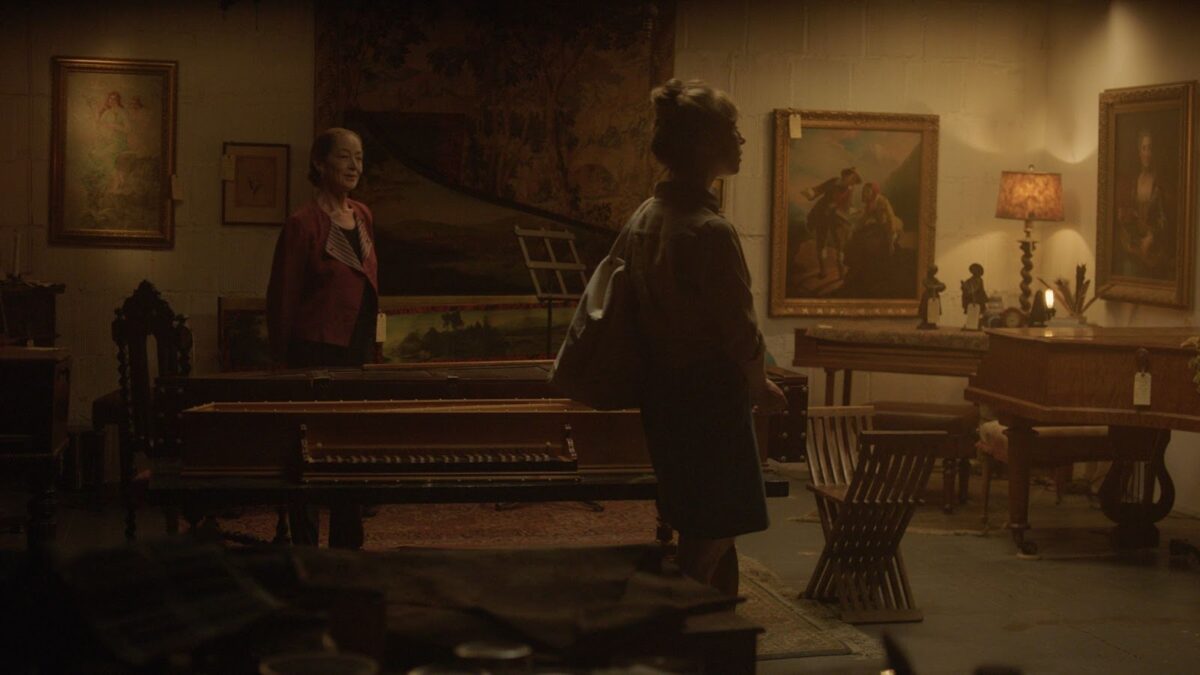
Around 10 minutes into the film, after the first musical performance, Cas describes her difficulty in reconciling classical and jazz, transitioning between the two. I’m wondering how that line resonates with you. How do you move between classical and jazz in your filmmaking?
That’s very much a line from Courtney herself, but obviously it’s in the finished film, so of course it resonates with me personally, too. Obviously when you think of classical versus jazz, you think ‘very structured, notated, and composed’ versus ‘very free and improvised and more instinctive.’ In filmmaking and music I don’t feel like I’m more beholden to one or the other way of thinking. It’s a struggle at some points. Within the film there is a lot of improvisation, even some of the ‘guided dialogues’ aren’t too scripted. But, at the same time, the film was also very structured. Every shot was written out even if the dialogue within it wasn’t. So there is a push-pull, but it’s not something I consciously think about. I think playing in that zone is where I’m comfortable. If it’s going to be freeform, then it has to have structure in one way or another, and if it’s not going to have any structure, there needs to be something very specific going on at the center of that structurelessness. It’s worth noting too that I was trained as a jazz guitarist, but I always wished I had more formal classical training too, so maybe there’s something there as well.
Staying on the subject of the film’s dialogue, it’s credited in a way I’ve never seen before: ‘feature dialogue by the cast.’ Can you tell me about the process of working with your actors to draw their characters and script the film?
In the entire finished movie there are only two scenes that are completely scripted. One of those is obvious. The other is maybe not so obvious. When I was casting musicians, I first thought that I could do some research on the musicians and talk to them to try and come up with things that they might say, written in the script. That ultimately didn’t feel right to do since I was basically casting these people as themselves. There weren’t many professional actors in the movie and there wasn’t much time to rehearse. I would tell them, ‘this scene is going to be about this’ or ‘we need to talk about this point.’ But, I mostly asked them to draw from their experience and say whatever they wanted to while hitting the key points. Curtis, who owns the hurdy-gurdy shop, he’s just speaking from his experience and knowledge of the instruments. I wasn’t going to give him lines to memorize or anything like that. Courtney isn’t usually an actress. She actually acted in one film around 20 years ago, Scumrock by Jon Moritsugu, but other than that she’s not really an actor. She’s a non-fiction and documentary filmmaker though and a very curious, outgoing person. So, she was an ideal choice to place in the center of this because it comes naturally to her to be inquisitive and lead conversations, especially with things that interest her like hurdy-gurdies or some of the musicians in the film. She was into Sarah Davachi’s music beforehand so she was naturally curious about Sarah’s work and could talk to her easily. Because of the circumstances, there wasn’t a ton of time for the actors to really get really acquainted with each other. Courtney, Sarah, and Whitney would Zoom together a bit, but it came down to casting the right people and putting them in their comfort zones both physically and with regards to the subject matter.
Topology of Sirens (2021) – Teaser Trailer from Omnes Films on Vimeo.
I think the only overt reference to video games occurs in the one sequence featuring yourself. It’s one of a few sequences where Cas seems to engage with an NPC (non-player character), somebody that was just sort of waiting for somebody to show up and kind of go through a dialogue tree. Was there any significance to casting yourself as the Audio Shop Clerk?
No significance. It was supposed to be someone else, but in classic independent film fashion, someone dropped out last minute and I thought I could just do it cause I knew what it needed to be. Tyler actually made a short iPhone film that I acted in that’s basically a replay of that scene in some ways. There is actually one other video game reference though, another explicit one. It’s kind of an Easter egg. When she’s looking at the map on the cork board, there’s a flier that says Fjords and Amulet, which was Courtney’s band in college. The venue at the bottom is Threepwood’s. Guybrush Threepwood is the main character of The Secret of Monkey Island which is the first adventure game that I remember playing.
Tell me about the beautiful shot that opens the film and introduces us to a location we won’t see until much later. How does the shot acclimatize the viewer and bring them into the film’s world?
I really love Hou Hsiao-Hsien’s Café Lumiere. I used to be very coy about this, but I don’t really care as much anymore. That’s the number one influence on this movie. I think if you watch that movie it’s like a skeleton key to my film in some ways. In fact, I thought some of the earlier drafts of the script were too embarrassingly similar to Café Lumiere. But as far as that first shot, I did it because Café Lumiere begins with an unrelated shot and then introduces us to the main character. It’s a shot of a train, since the film is an Ozu tribute. When I was first structuring the film, I thought, ‘how does Café Lumiere start?’ I put it in there and it stuck. Why I think it works, why I kept it, was not so much to tell people what kind of film they were about to see, but it does function like an overture. There is a musical element to the sound design of that shot as well.
That’s interesting you mention an overture. Sticking to the video game metaphor, I had seen it as something like a loading screen.
It’s the start menu of the movie for sure.
Could you name some of the other films and filmmakers who influenced the film? I thought about Apichatpong Weerasethakul a lot and I’m sure people have made the Memoria connection.
The film actually premiered just one week after Memoria. It premiered at FID Marseille and Apichatpong was the guest of honor at the festival. He came to the premiere of Topology, which is pretty cool. He told me he liked it. I love Apichatpong’s movies, especially the sound design of Cemetery of Splendor which was kind of a technical reference point. That movie also gives you the sense of being cradled by the sound from beginning to end — there aren’t really any breaks in the sound. There are all these very drawn out sound transitions which very much appealed to me. Other than that, I mentioned Jim Jarmusch. When I was going into Topology, in my mind, it was really Café Lumiere meets The Limits of Control, which is a pretty weird combination. Have you seen Limits of Control?
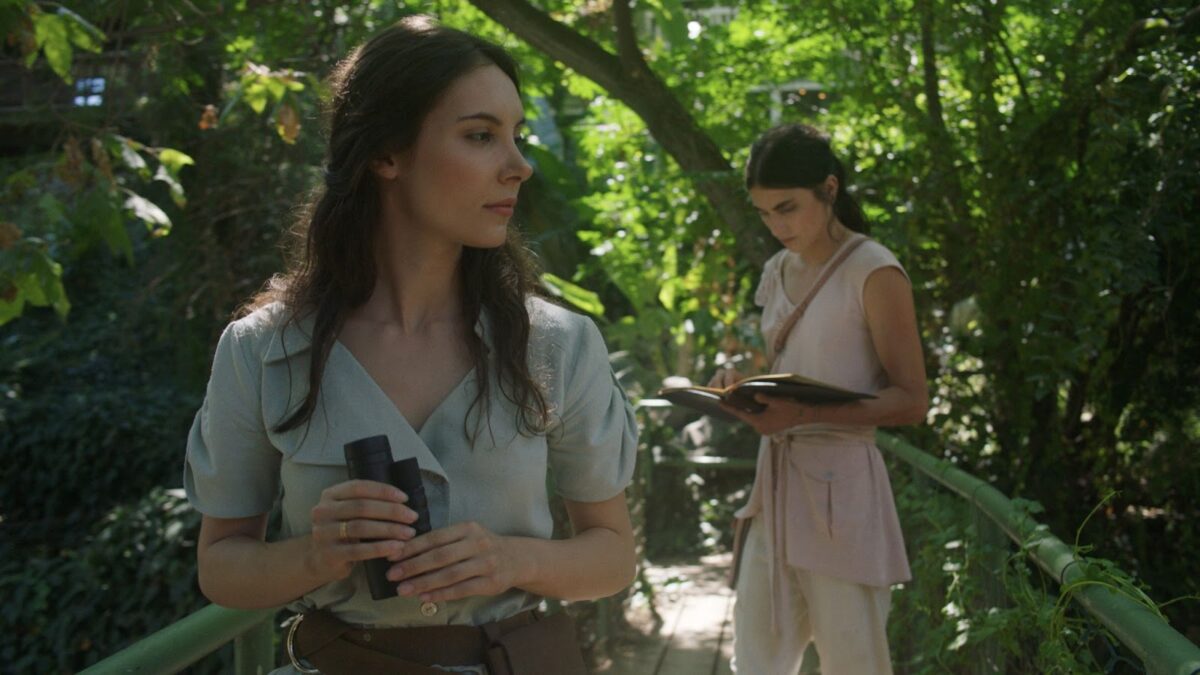
I have. I think it’s my favorite of his features.
That’s an opinion I think I share. There were some scenes we shot and had to cut that made it more Limits of Control. I think there’s still a little bit there because that movie always resembles an adventure game to me. And it has all this drone metal like Earth and Boris. So it’s like, this is the coolest fucking movie, right? When I was starting out I had those two movies in mind and that kind of returns to your question about jazz and classical. Café Lumiere is a very loose film and there was no script. I don’t think there was even an outline. The dialogue was all improvised. The shot structure, from what I understand, was improvised. It’s kind of a movie that he made on the spot with the actors whereas Limits of Control is this very tight, precise thing, or at least that’s how it reads. Those are the two big ones. Jacques Rivette was also a big influence on me. This might sound really strange, but Ferris Bueller’s Day Off is one of my favorite movies and I think there’s a lot of that in this movie. If you line them up they’re actually very similar, structurally.
Maybe it was just the association with Ham on Rye, but I got a little worried when the sirens show up and Cas disappears. Were you always sure that you were going to return to Cas at the end of the film and, if so, why did you think it was important to do that?
Yeah. I was always sure it would end with her. Especially because the siren sequence came later, almost a few weeks or a month before filming. There’s obviously change and growth throughout the film, but I don’t think she’s discovered anything too grand or earth shattering, she’s still going through it, as it were. The film was always designed to be a slice-of-life story. We start with one person and end at a point not too long after. Even if there are these moments of magical realism or mythical affectations at points, it’s still, at its heart, a slice-of-life film to me.
Topology of Sirens is currently streaming on Mubi
Stay up to date with all things Split Tooth Media and follow Bennett on Letterboxd
(Split Tooth may earn a commission from purchases made through affiliate links on our site.)

